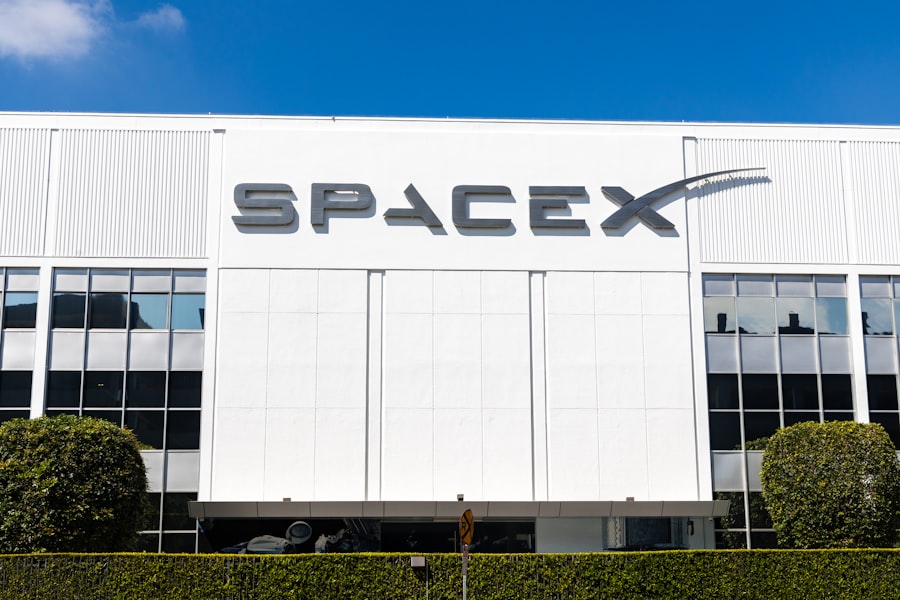The emergence of SpaceX’s Starship has marked a significant turning point in the landscape of space exploration. Initially conceived as a fully reusable spacecraft capable of carrying both crew and cargo to a variety of destinations, Starship has rapidly evolved into a symbol of innovation and ambition in the aerospace industry. With its towering height and sleek design, the spacecraft embodies the vision of making interplanetary travel not just a dream but a tangible reality.
The successful test flights and ongoing development have captured the imagination of the public and the scientific community alike, showcasing the potential for a new era in space travel. SpaceX’s relentless pursuit of technological advancement has propelled Starship into the spotlight. The company’s founder, Elon Musk, has articulated a bold vision for humanity’s future among the stars, emphasizing the need for a multi-planetary existence.
This ambition has driven significant investments and research into the spacecraft’s capabilities, including its ability to transport large numbers of passengers and cargo to destinations such as the Moon and Mars. As Starship continues to undergo rigorous testing, it stands as a testament to human ingenuity and the possibilities that lie beyond Earth.
Key Takeaways
- SpaceX Starship is revolutionizing space exploration with its reusable rocket technology and ambitious plans for interplanetary travel.
- Traditional space powers are facing challenges from the rise of private companies like SpaceX, leading to a shift in the geopolitical landscape of space exploration.
- Space exploration is being redefined by the increasing involvement of private companies, with a focus on commercial opportunities and resource extraction.
- Private companies like SpaceX are playing a significant role in shaping space geopolitics, challenging the dominance of government-led space programs.
- The race for lunar and Martian resources is intensifying, with private companies and traditional space powers vying for access and control.
The Impact on Traditional Space Powers
The rise of SpaceX and its Starship program has sent ripples through the established space powers, challenging their long-held dominance in space exploration. Traditional agencies like NASA, Roscosmos, and the European Space Agency have historically been at the forefront of space missions, but the advent of private companies like SpaceX has introduced a new dynamic. These traditional powers are now compelled to reassess their strategies and partnerships in light of the rapid advancements made by private entities.
The competitive landscape has shifted, prompting these agencies to explore collaborations with SpaceX rather than viewing it solely as a rival. Moreover, SpaceX’s cost-effective approach to launching payloads has forced traditional space agencies to reconsider their budgeting and operational models. The ability to launch missions at a fraction of the cost previously incurred has made space more accessible than ever before.
This shift not only democratizes access to space but also pressures established agencies to innovate and streamline their processes. As a result, traditional powers are increasingly looking to leverage private partnerships to enhance their capabilities and maintain relevance in an evolving space race.
Redefining Space Exploration

SpaceX’s Starship is not just a vehicle; it represents a paradigm shift in how humanity approaches space exploration. The focus on reusability and cost efficiency has redefined mission planning and execution. In contrast to previous models that relied heavily on expendable rockets, Starship’s design allows for multiple flights with minimal refurbishment, significantly reducing the financial barriers associated with space travel.
This innovation opens up new possibilities for scientific research, commercial ventures, and even tourism in space. Furthermore, the ambitious goals set forth by SpaceX have inspired a renewed interest in deep space exploration. With plans for missions to Mars and beyond, Starship serves as a catalyst for international collaboration and competition alike.
The prospect of establishing human settlements on other planets is no longer confined to science fiction; it is becoming an achievable objective. This shift in mindset encourages not only governmental agencies but also private enterprises to invest in technologies that will support long-term human presence beyond Earth.
The Role of Private Companies in Space Geopolitics
| Private Companies | Role in Space Geopolitics |
|---|---|
| SpaceX | Developing reusable rockets, reducing launch costs, and partnering with NASA for space missions |
| Blue Origin | Developing reusable rockets and working on lunar lander for NASA’s Artemis program |
| Virgin Galactic | Developing space tourism and suborbital spaceflights |
| Lockheed Martin | Developing spacecraft and technologies for space exploration and national security |
The ascent of private companies like SpaceX has fundamentally altered the geopolitical landscape of space exploration. As nations grapple with their own ambitions in space, private entities are emerging as influential players in this arena. The ability of companies to launch satellites, conduct research, and even transport astronauts has blurred the lines between national interests and commercial endeavors.
This new reality necessitates a reevaluation of how countries engage with one another in matters related to space. In this evolving context, private companies are not merely service providers; they are becoming key stakeholders in international relations. Their capabilities can enhance national security, economic growth, and technological advancement.
As governments increasingly rely on private firms for access to space, they must navigate complex relationships that involve both collaboration and competition. This dynamic creates opportunities for innovation but also raises questions about accountability and governance in an arena that is becoming increasingly privatized.
The Race for Lunar and Martian Resources
As SpaceX continues to develop Starship, the race for resources on the Moon and Mars is intensifying. The potential for mining valuable materials such as water ice, rare minerals, and even Helium-3 has captured the attention of both governmental agencies and private enterprises. The Moon is seen as a stepping stone for deeper space exploration, while Mars represents a frontier rich with possibilities for resource extraction.
SpaceX’s ambitions align with these goals, positioning it as a key player in this emerging market. The implications of resource extraction extend beyond mere economic gain; they also raise questions about sustainability and environmental stewardship in space. As nations and companies vie for control over extraterrestrial resources, it becomes imperative to establish frameworks that govern these activities responsibly.
The potential for conflict over resources could mirror historical territorial disputes on Earth, underscoring the need for international cooperation and regulation in this new frontier.
The Challenge to International Space Cooperation

The rise of private companies like SpaceX poses significant challenges to international cooperation in space exploration. Historically, nations have collaborated on ambitious projects such as the International Space Station (ISS), pooling resources and expertise for mutual benefit. However, as private entities enter the fray, the dynamics of collaboration are shifting.
Countries may find themselves competing not only with one another but also with powerful corporations that have their own agendas. This competitive atmosphere can hinder collaborative efforts that are essential for addressing global challenges such as climate change or planetary defense. While private companies can drive innovation and efficiency, they may also prioritize profit over shared goals.
As nations navigate this complex landscape, they must find ways to balance competition with collaboration to ensure that space exploration remains a collective endeavor rather than a battleground for corporate interests.
The Potential for Commercial Space Tourism
One of the most exciting prospects associated with SpaceX’s Starship is its potential to revolutionize commercial space tourism. As advancements continue, the dream of ordinary citizens traveling beyond Earth’s atmosphere is becoming increasingly feasible. SpaceX’s commitment to developing a spacecraft capable of carrying passengers safely into orbit opens up new avenues for adventure and exploration that were once reserved for astronauts alone.
The implications of commercial space tourism extend beyond mere leisure; they represent an opportunity for economic growth and technological advancement. As more companies enter this burgeoning market, competition will likely drive down costs while enhancing safety measures. However, this rapid expansion also raises questions about accessibility and equity—who will be able to afford these experiences?
Addressing these concerns will be crucial as society navigates this new frontier of human experience.
The Military Implications of SpaceX Starship
The military implications of SpaceX’s Starship cannot be overlooked in discussions about its impact on space exploration. As nations recognize the strategic importance of space, military interests are increasingly intertwined with commercial endeavors. The capabilities offered by Starship—such as rapid deployment of satellites or even military assets—present both opportunities and challenges for national security.
Countries may seek to leverage private companies like SpaceX for defense purposes, leading to partnerships that blur the lines between commercial and military operations. This convergence raises ethical questions about accountability and oversight in an arena where national security interests can conflict with commercial objectives. As military applications of space technology continue to evolve, it will be essential for policymakers to establish clear guidelines that govern these activities while ensuring transparency and accountability.
The Environmental Impact of Space Exploration
As humanity ventures further into space, it is crucial to consider the environmental impact of these endeavors. The launch of rockets generates significant emissions that contribute to atmospheric pollution, raising concerns about climate change even beyond Earth’s atmosphere. Additionally, the potential for debris accumulation in orbit poses risks not only to satellites but also to future missions aimed at exploring deeper into space.
SpaceX’s commitment to reusability with Starship offers a promising avenue for mitigating some environmental impacts associated with traditional rocket launches. By reducing waste through reusable components, there is potential for a more sustainable approach to space travel. However, as exploration expands beyond Earth’s orbit, it becomes imperative to develop comprehensive strategies that address environmental concerns while balancing the desire for progress in space exploration.
The Ethical and Legal Considerations of Space Geopolitics
The rise of private companies like SpaceX brings forth numerous ethical and legal considerations in the realm of space geopolitics. As nations grapple with their ambitions in outer space, questions arise regarding ownership rights over celestial bodies and resources. The Outer Space Treaty of 1967 established foundational principles governing outer space activities; however, its applicability in an era dominated by commercial interests remains uncertain.
Furthermore, ethical dilemmas emerge when considering the implications of resource extraction on other celestial bodies. How should humanity approach mining operations on Mars or the Moon? What responsibilities do nations and corporations have toward preserving these environments?
These questions necessitate thoughtful dialogue among stakeholders to ensure that future endeavors align with ethical standards while promoting sustainable practices in space exploration.
The Future of Space Governance and Regulation
As humanity stands on the brink of a new era in space exploration driven by innovations like SpaceX’s Starship, the need for effective governance and regulation becomes increasingly urgent. The complexities introduced by private companies operating alongside national agencies require frameworks that can adapt to rapidly changing technologies and geopolitical dynamics. Establishing clear guidelines will be essential for ensuring responsible behavior in outer space while fostering collaboration among diverse stakeholders.
As nations come together to address shared challenges—such as resource management or environmental protection—there is an opportunity to create comprehensive regulatory frameworks that reflect collective interests rather than individual ambitions. By prioritizing collaboration over competition, humanity can navigate this new frontier responsibly while maximizing the benefits of exploration beyond Earth’s atmosphere.
In conclusion, SpaceX’s Starship represents more than just a technological marvel; it embodies a transformative shift in how humanity approaches space exploration and geopolitics. As traditional powers adapt to this new landscape dominated by private companies, the implications extend far beyond mere competition—they encompass ethical considerations, environmental impacts, and the future governance of outer space itself. As we look ahead, it is imperative that stakeholders engage in meaningful dialogue to ensure that humanity’s journey into the cosmos is guided by principles that prioritize sustainability, equity, and cooperation among all nations.
The launch of SpaceX’s Starship has significantly altered the landscape of space geopolitics, marking a pivotal shift in how nations approach space exploration and collaboration. With its unprecedented payload capacity and reusability, Starship is poised to reduce the cost of access to space, thereby democratizing space travel and exploration. This development has prompted countries to reassess their space strategies and partnerships, as they seek to leverage the new opportunities presented by this technological advancement. For a deeper dive into how SpaceX’s innovations are reshaping international space relations, you can read a related article on this topic by visiting Real Lore and Order.
WATCH THIS! 🚀 Why The Moon Is The Next Battlefield: The Geopolitics of Cislunar Space
FAQs
What is SpaceX Starship?
SpaceX Starship is a fully reusable spacecraft designed for missions to Earth orbit, the Moon, Mars, and beyond. It is being developed by SpaceX, the aerospace company founded by Elon Musk.
How does SpaceX Starship change space geopolitics?
SpaceX Starship has the potential to change space geopolitics by making space travel more accessible and affordable. This could lead to increased competition in space exploration and potentially shift the balance of power among spacefaring nations.
What are the geopolitical implications of SpaceX Starship?
The development and successful deployment of SpaceX Starship could lead to increased collaboration and competition in space exploration, as more countries and private companies seek to establish a presence in space. This could impact international relations and geopolitical dynamics on Earth.
How does SpaceX Starship impact international space cooperation?
SpaceX Starship could impact international space cooperation by providing a more cost-effective means of sending payloads and astronauts into space. This could lead to new partnerships and collaborations among countries and organizations involved in space exploration.
What are the potential benefits of SpaceX Starship for space exploration?
SpaceX Starship has the potential to significantly reduce the cost of space travel and enable missions to destinations such as the Moon and Mars. This could accelerate the pace of space exploration and open up new opportunities for scientific research and commercial activities in space.
